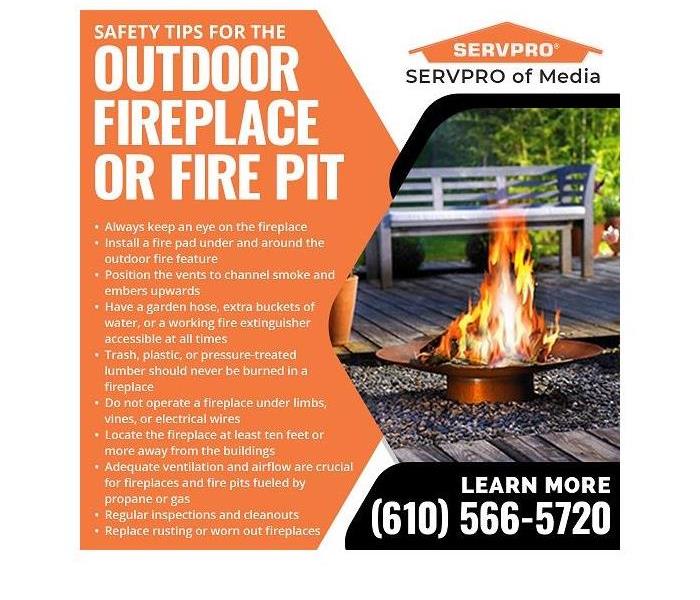Safe Practices for Enjoying Outdoor Fireplaces and Avoiding Fire Damage
9/14/2021 (Permalink)
Blog Summary: Many homeowners love to sit outside around the outdoor fireplace on a summer evening. SERVPRO of Media highlights fire safety tips related to outdoor fireplaces to help homeowners safely enjoy this activity.
SERVPRO of Media, PA, is dedicated to helping local residents recover from property damage disasters, including the aftermath of fire damage. The restoration process for fire damage involves smoke damage, water damage from the efforts to extinguish the blaze, and mold issues from that water. To help Newtown Square, PA and Central Delaware County residents safely enjoy time around the outdoor fireplace, the Media SERVPRO professionals offer these fire prevention safety tips.
Many homeowners enjoy lounging outside around the outdoor fireplace on a summer or fall evening. Outdoor fireplaces account for nearly four thousand grass and wildfires each year. Though enjoyable, outdoor fire features do pose a hazard, according to the National Fire Protection Association. Homeowners should be aware that outdoor fireplaces need the same maintenance and attention to safety as indoor fireplaces. These outdoor fireplace safety tips will keep family, friends, and pets safe.
Purchase a Safe and Reliable Outdoor Fireplace
Select the safest model. Look for the following features:
- Size: The firebox needs to comfortably handle three or four 16-inch standard-cut fire logs.
- Weight: If the unit needs to be portable, make sure it is light enough to easily maneuver around the patio or porch without tipping over.
- Thickness: A thin-walled firebox will not stand up under heavy usage. A firebox with a thicker wall is better.
- Cover: Purchase a unit with a lid. The lid prevents debris and ashes from littering the area around the fireplace.
- Fuel shutoff: Gas or propane units should have accessible controls, especially the gas shutoff valve.
- Vents and screens: Choose a unit with screens, smoke vents, and mesh protection that prevents embers from escaping and possibly causing fire damage.
The purchase of a safe fireplace unit is the best first step to a safe outdoor fireplace experience. Proper installation, use, and maintenance are essential to avoid damage to the unit and to prevent fires and personal injury. Keep these safety tips in mind when enjoying the outdoor fireplace or fire pit.
- Always keep an eye on the fireplace. An unattended fireplace, even if the screen is in use, is a potential fire hazard.
- Install a fire pad under and around the outdoor fire feature if the unit will not be installed on a brick, stone, or concrete foundation. Avoid using a fireplace on an unprotected wooden deck.
- Position the vents to channel smoke and embers upwards.
- Have a garden hose, extra buckets of water, or a working fire extinguisher accessible at all times.
- Trash, plastic, or pressure-treated lumber should never be burned in a fireplace. These items produce toxic gases that can cause serious respiratory issues.
- Do not operate a fireplace under limbs, vines, or electrical wires.
- Locate the fireplace at least ten feet or more away from the home, garage, shop, or storage buildings.
- Adequate ventilation and airflow are crucial for fireplaces and fire pits fueled by propane or gas.
- A clean and debris-free outdoor fireplace is safest. Regular inspections and cleanouts are recommended.
- Rusting and wear indicate that a fireplace needs to be taken out of service and replaced.
By purchasing a better-quality fireplace and following these recommendations for operation, homeowners can safely enjoy an outdoor fire.
Traditional Fire-Starting Tips for the Homeowner
The use of accelerants such as lighter fluid, motor oil, diesel, and gasoline is dangerous. For a safe, controlled, and steady burn, use dry wood. The process of starting a fire begins with gathering dry material and firewood.
- Tinder: Tinder consists of pine needles, pine cones, birch or cedar bark shavings, cotton balls, and dryer lint.
- Kindling: This next layer of material in the fire preparation process includes twigs, small sticks, and wood splinters about an inch in diameter. Stack the kindling over the layer of tinder in a pyramid. Ignite the heap with a match or long-stemmed lighter.
- Fatwood: Fatwood, a form of kindling from split pine tree stumps, is high in flammable resin content. As the wood dries out and hardens, the sap concentrates, making fatwood an efficient natural fire starter. Fatwood kindling can be laid crisscross or in a pyramid shape over the tinder.
- Slab wood: Slab wood is the bark edge of a log. Similar in appearance to pallet wood, slab wood is almost all sapwood and burns hot and quick. Fatwood and slab wood create an excellent base for starting larger fire logs or split wood.
- Standard-cut fire logs: Standard-cut firewood is usually about sixteen inches in length. Put these logs on the fire when the base is well-established.
These tips are intended to make time spent around the fireplace pleasurable and safe. However, should a fire damage disaster occur, SERVPRO of Media is available 24/7, 365 days a year, to assist homeowners with fire damage restoration and recovery efforts. From start to finish, SERVPRO of Media can handle everything, including insurance claims.
For more information about fire damage restoration in Newtown Square, PA, contact SERVPRO of Media by phone at (610) 566-5720. The team of fire damage restoration experts can also be contacted by email at office@SERVPROmedia.com





 24/7 Emergency Service
24/7 Emergency Service
